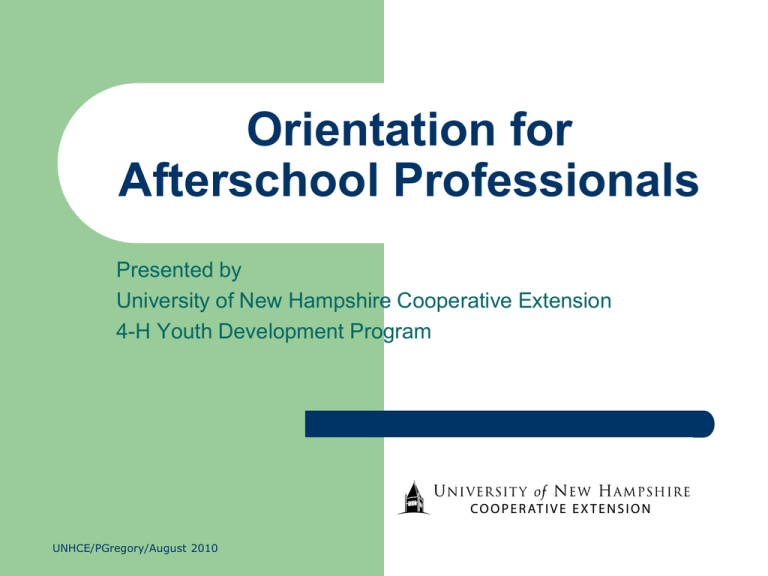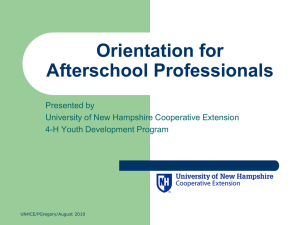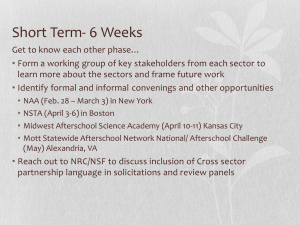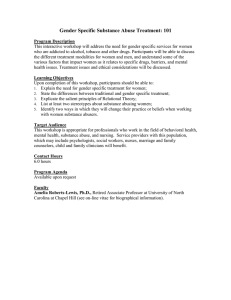Orientation for Afterschool Professionals Presented by University of New Hampshire Cooperative Extension
advertisement

Orientation for Afterschool Professionals Presented by University of New Hampshire Cooperative Extension 4-H Youth Development Program UNHCE/PGregory/August 2010 Who are we? Why are we here? Training Goals Understand QUALITY Examine RULES Explore PROFESSIONALISM Focus on YOUTH Consider FAMILY & COMMUNITY Keys to Success in the Field Program & Environment Professionalism & Leadership Child & Youth Development Family, School & Community Core knowledge Areas defined by the NH Afterschool Professional Development System, 2010. Ground Rules •Experience the day! •Have fun! •Respect others •Share the air •Tend to own needs •Silence technology 3-2-1 Letter to Myself 3 things I will start doing or will change 2 things I learned that I already do well 1 thing I will do to continue learning What do we already know? Research Tells Us Youth Need… Variety Asset of programs building experiences Youth Acquire Assets Through … Exposure to positive Experiences Settings People (8 Essential Elements) Key Element #1 Caring Adult Supportive Positive Responsive Communication Consistency Youth Opportunities Unlimited (YOU), 1994 Key Element #2 Inclusive Environment Diversity Cultural celebrations Respect Identity Mask making at Seacoast Youth Services, 2008 Key Element #3 Safe Place Emotional safety Physical safety Screening Ground rules Trust Urban forestry, Youth Opportunities Unlimited (YOU), 1992 Key Element #4 Learning Opportunities Choices Variety Experiential Age-appropriate Challenging Youth Opportunities Unlimited (YOU), 1993 Key Element #5 Mastery of Skills Intentional Peer teaching Recognition Age-appropriate Making paper, Youth Opportunities Unlimited (YOU), 1992 Key Element #6 Active Participants in the Future Empowerment Planning Networking Challenges Careers Maximus Raceway, community partner, Seacoast Youth Services, 2009 Key Element #7 Self-Determination / Leadership Leadership Voice Hands-on Self-reliance Corn Maze, Seacoast Youth Services, 2006 Key Element #8 Service to Others Project planning Giving / doing Processing Summer of Service, Seacoast Youth Services, 2008 BELONGING MASTERY Positive Relationship with a caring adult Engagement in Learning Opportunity for Mastery An inclusive environment A safe environment INDEPENDENCE GENOROSITY Opportunity to see oneself as an active participant in the future Opportunity to value and practice service for others Opportunity for self-determination Core Knowledge Area #1 Program & Environment Power of Environments Environments teach us about the value and knowledge of those who create them. Chipping items out of frozen ice. ASOP training, Amy Upton, 2010 What is Implied? Pancake making – preparing own snacks. ASOP training, 2010 Planning Each environment influences those who use it. ASOP training, Amy Upton, 2010. Environments may be… Over-stimulating Boring Calming Agitating Quiet space, ASOP Training, Amy Upton, 2010 Fostering creativity … with a variety building materials ASOP Training, Amy Upton, 2010 Teamwork… Art with melted crayons, ASOP Training, Amy Upton 2010 Key point… Learning environments that are: – well designed – structured – engaging foster positive behavior and create a culture of creativity. Learning Strengths Verbal - Linguistic Mathematical - Logical Visual - Spatial Bodily / Kinesthetic Musical Interpersonal Intrapersonal Naturalistic Diversity in Learning Styles These invitations appeal to the senses of smell and touch. ASOP Training, Amy Upton, 2010 Core Knowledge Area #2 Professionalism & Leadership •Standards of Quality – licensing •Reporting child abuse /neglect •Professionalism - credential Child Care Licensing Programs for ages 0-18 Baseline standards of safety and quality License programs (not people) – – – Safety, First Aid, CPR Staff Background, Positions, Training Ratios Safety Rules Trip and fall hazards Emotional safety First Aid & CPR 1 staff currently certification / 20 children Fingerprinting All staff over age 17 by 1st day Licensing Ratios – for ages 60 months + (age 5+) Maximum 45 children / room And… 1 - 15 children : 1 group leader 16 - 30 children: 1 group leader 1 assistant group leader 31 - 45 children: 1 site director 2 assistant group leaders Licensing: Direct Service Professionals Required Annual Training Hours – – Revised in 2013 Based on Levels in the Lattice System Professional Development Defined – – – – Includes Self Study Face to face professional development relevant to afterschool Minimum of 12 Hrs per year Level 1 Minimum of 18 Hrs per year Level 2-6 Child Abuse: MANDATED Reporting Anytime you suspect there is abuse and/or neglect you are mandated to report! Mandated Reporting Internal protocols (i.e. informing a superior or requesting superior’s permission prior to reporting) are NOT the law or DCYF policy – – If unable to meet with supervisor immediately, make the report to DCYF and follow up with your supervisor later If you suspect abuse and/or neglect you are mandated to report even if your supervisor does not agree! You Are Protected if You Report! Anyone participating in good faith in the making of a report pursuant to this chapter is immune from any liability, civil or criminal, that might otherwise be imposed. RSA 169-C:31 and RSA 161-F:47 You can request that your name be kept confidential! Child Abuse: What to Report Physical abuse Sexual abuse Neglect Emotional or psychological maltreatment To Report Suspected Abuse Child Abuse Report Line 1-800-894-5533(in state) 603-271-6562(out of state) After hours, weekends, holidays CALL 911 DHHS Resources Licensing website: http://www.dhhs.nh.gov/oos/cclu/ Credential website: http://www.dhhs.nh.gov/dcyf/cdb/profdev.htm Child Abuse Reporting contact: http://www.dhhs.nh.gov/dcyf/cps/ Afterschool Credential Benefits to Individual Recognizes professional knowledge, experience Verifies you are qualified Defines a ladder for professional growth Defines knowledge and skills to deepen practice Benefits to program Enables program to prove qualifications of staff NH Afterschool Professional Development System (2013) Child Development Bureau Division for Children, Youth and Families NH Dept of Health and Human Services. http://www.dhhs.nh.gov/dcyf/cdb/profdev.htm My Lifeline DOB Current date DOB +70 Core Knowledge Area #3 Child & Youth Development Developmental stages are predictable sequences of growth and change Seacoast Youth Services, 2008 How old is a child? 8 years…………………………… 7 years………………………….. 6 years……………………………………………………………………………. 5 years……………………………………………………………………………. 4 years……………………………………………………………………………. Chronological Age Physical Age Mental Age Social Age Emotional Age Ages & Stages of Development Grades K-2 Grades 3-5 Grades 6-8 Grades 9-12 Characteristics and Teaching Tips Ages & Stages Keys to successful programming: – – Age is not a predictor of maturity Growth may proceed at different rates Core Knowledge Area #4 Family, Community & School Programs that reach family, community, and schools make a difference. Seacoast Youth Services, 2007 Ecological Model (Urie Bronfenbrenner) Society Community Relationships Family, Peers Youth Keys to Success with Youth Society Community Relationships Family, Peers Positive Activities Youth Positive Peers Strong Family Involving Parents • Why is it important? •How can we engage parents? Hillsboro Kids in Gear, staff, parents, community partners, 2006 Family Involvement Ideas Invent a game!! Now what do we know? Final Details Certificate of Attendance NH Afterschool Orientation 3 hours ____________________________ (your name) Todays Date__________ Workshop Trainers _____________________ _____________________ Thank You! Presented by In partnership with New Hampshire Afterschool Coalition (NHASC) UNHCE/Gregory/August 2010




